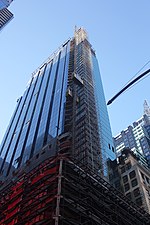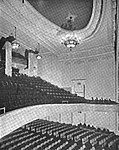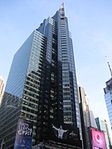Embassy Theatre (New York City)

The Embassy Theatre, also known as the Embassy 1 Theatre, is a former movie theater at 1560 Broadway, along Times Square in the Midtown Manhattan neighborhood of New York City. Designed by Thomas W. Lamb, the theater opened in 1925 at the ground floor of 1560 Broadway, the headquarters of the Actors' Equity Association. While no longer in use as a theater, the space is preserved as a New York City designated landmark, and it continues to operate as a store. The theater interior is accessed by an entrance vestibule, which connects to an outer lobby with marble trim and a coved ceiling. The inner lobby, decorated with woodwork and mirrors, was originally used to sell tickets; it was designed in a similar manner to the outer lobby. The auditorium originally had 598 seats, which were arranged on a single raked floor, facing a proscenium arch with a movie screen. The side walls of the auditorium contain piers with lighting fixtures, behind which are murals by Arthur Crisp. The ceiling contains plasterwork decoration and lighting fixtures by Rambusch Decorating Company, including a central recessed dome. These design details remain intact except for the removal of the original seats and movie screen. The theater opened on August 26, 1925, and was originally operated by Metro-Goldwyn-Mayer (MGM). Its first manager, Gloria Gould, staffed the theater almost exclusively with young women. After Guild Enterprises began operating the Embassy in 1929, the theater became the first newsreel theater in the United States. The decline of the newsreel format forced the Embassy to revert to showing films in 1949. The New York City Landmarks Preservation Commission designated the theater as an interior landmark in 1987, and the Embassy showed its last film in 1998. The Times Square Business Improvement District renovated the theater into a visitor center, which operated from 1998 to 2014. Following another renovation, the Embassy reopened in 2019 as a store themed to soccer star Pelé.
Excerpt from the Wikipedia article Embassy Theatre (New York City) (License: CC BY-SA 3.0, Authors, Images).Embassy Theatre (New York City)
West 46th Street, New York Manhattan
Geographical coordinates (GPS) Address Nearby Places Show on map
Geographical coordinates (GPS)
| Latitude | Longitude |
|---|---|
| N 40.7586 ° | E -73.98447 ° |
Address
West 46th Street 167
10036 New York, Manhattan
New York, United States
Open on Google Maps










